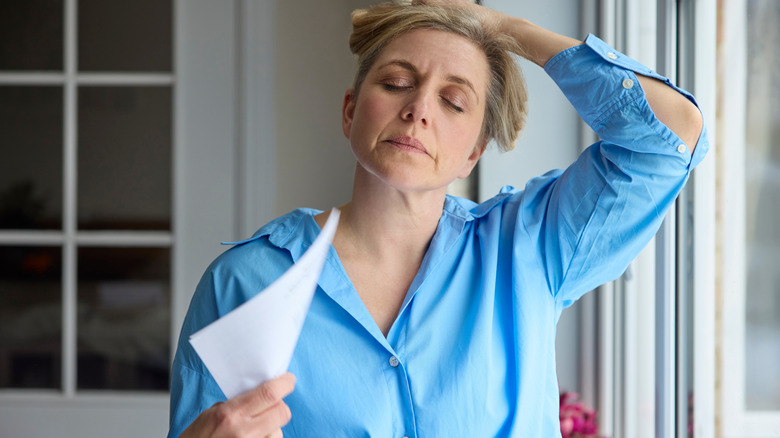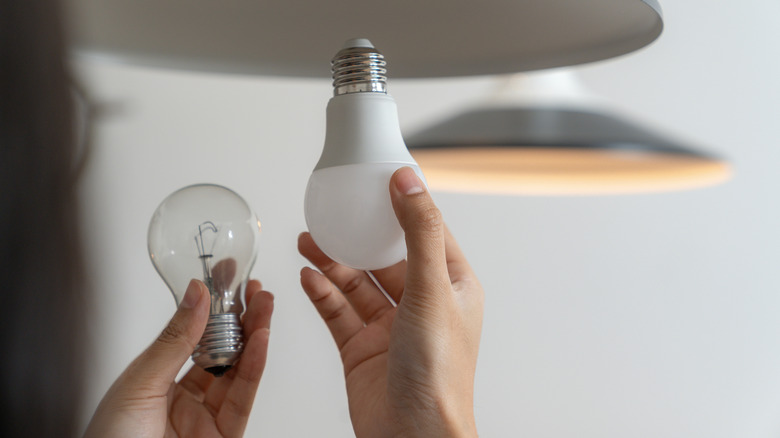The Surprising Reason Your House Is Always Too Hot
If you constantly turn down the thermostat or open a window to cool things off, the reason behind your home's heat may surprise you: lighting. Specifically, fixtures or lamps with old incandescent or halogen bulbs may warm up your home more than realized. Each time you switch one on, you add a significant amount of heat to your space. Per the U.S. Department of Energy, incandescent bulbs release 90% of their energy as heat, not light. Halogen lights, often used in spotlights, produce less light energy than heat as well. A room full of either bulbs can quickly turn into a sauna.
The first long-lasting incandescent bulb arrived in 1879, with halogen bulbs coming along in the 1950s. Both were a mainstay of American homes for over a century. Eventually, the United States enacted new rules for "general service lamps," aka lightbulbs, to phase out less efficient models. The standard required every new bulb to produce 45 lumens per watt. Lumens refers to the brightness of a bulb. There were also exemptions, such as bulbs for appliances and bug lights. General use incandescent light bulbs only offer 13 to 14 lumens per watt, while halogen bulbs offer a slightly better 16 to 21 lumens per watt, so both don't work under the new regulations. Today, when shopping for light bulbs, you're typically considering LED (light-emitting diode ) bulbs over these older models, unless purchasing for a specific appliance. While you can't buy incandescent bulbs in-store due to these federal standards, it's possible you might have one or two lingering in a box. Perhaps you even accidentally swapped one for a burnt bulb.
Why switch to LEDs over incandescent and halogen bulbs in your home
LED bulbs are the most energy efficient bulbs, generating light up to 90% more efficiently than other lighting options. Unlike the traditional bulbs, LEDs distribute light in only direction and produce less heat, reducing wasted energy. When comparing LED bulbs to incandescent, you'll notice that incandescent bulbs feature a slightly yellowish tint, which can make it easier to find them in your home. They will also generate significantly more heat. These older bulbs are commonly used in dining room chandeliers and bedroom lamps. These bulbs are typically made of glass, with a visible filament, the metal part that creates light from electrical contact. They often become hot to the touch and must cool for safe handling.
The other common heat-producing bulbs, halogens, are also found in various spots throughout your home. They tend to appear in under-cabinet lights as well as in recessed or spotlight fixtures. Like incandescent bulbs, they can get very hot. If installed overhead, such as in task lighting, and often in use, you may observe your home gets noticeably hot. Once you know how less efficient bulbs can contribute to your warmer home, you can make some smart swaps to LED bulbs to reduce the light-generated heat while also improving your comfort.
Making smart choices to cool down your home
One of the easiest fixes is simply switching out your older bulbs for new LED options. LED lights don't work as hard as the previous light bulb types, so they use less energy and produce less heat while providing the same amount of light. As a result, you'll not only reduce the lighting heat in your home, but you'll also save on energy costs, with an average annual savings of $225 after switching. If you don't want to go through your lighting room by room to find the outdated bulbs, start in the areas of your home where you feel the most warmth. If possible, look at your overhead light fixtures to see what type of bulbs they currently use. Determine if you want to swap them out for LED options. Consider also making the switch in your bedroom and other frequently used spaces.
While appliance bulbs are exempt from the government regulations, many manufacturers now make LED replacement bulbs for microwaves and ovens, so you can also upgrade these while you're busy making the switch in your lights. Then, if you still feel the heat after changing out a few bulbs, try other ways to cool down a room. These methods include running a ceiling fan counterclockwise to push cooler air downward and closing your curtains during the hotter summer days.


